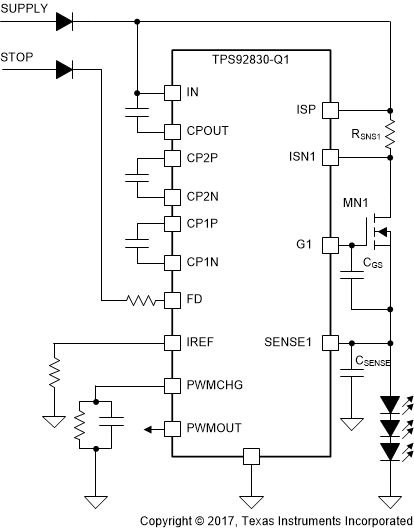SLIS178B October 2017 – January 2018 TPS92830-Q1
PRODUCTION DATA.
- 1 Features
- 2 Applications
- 3 Description
- 4 Revision History
- 5 Description (Continued)
- 6 Pin Configuration and Functions
- 7 Specifications
- 8 Detailed Description
- 9 Application and Implementation
- 10Layout
- 11Device and Documentation Support
- 12Mechanical, Packaging, and Orderable Information
Package Options
Mechanical Data (Package|Pins)
- PW|28
Thermal pad, mechanical data (Package|Pins)
- PW|28
Orderable Information
8.3.3.2 High-Side Current Driving
To regulate the output current, the gate-source voltage of the external MOSFET must be regulated accordingly. The constant-current source is used to charge and discharge the N-channel MOSFET gate. During the current-slewing period, constant-current sourcing and sinking ensures the smooth slewing of the output current. The control loop requires sufficient MOSFET gate capacitance to ensure loop stability. In case the MOSFET gate capacitance is insufficient, a capacitor CGS must be added across Gx and SENSEx. TI also recommends always putting a CSENSE of 10 nF from each of the SENSEx pins to GND, and close to the device for EMC.
When a channel is switched on, current source I(DRV_source) charges the gate of the external N-channel MOSFET. When a channel is switched off, current sink I(DRV_sink) discharges the gate of the external MOSFET transistor down to ground.
 Figure 21. MOSFET Gate Capacitance Compensation
Figure 21. MOSFET Gate Capacitance Compensation